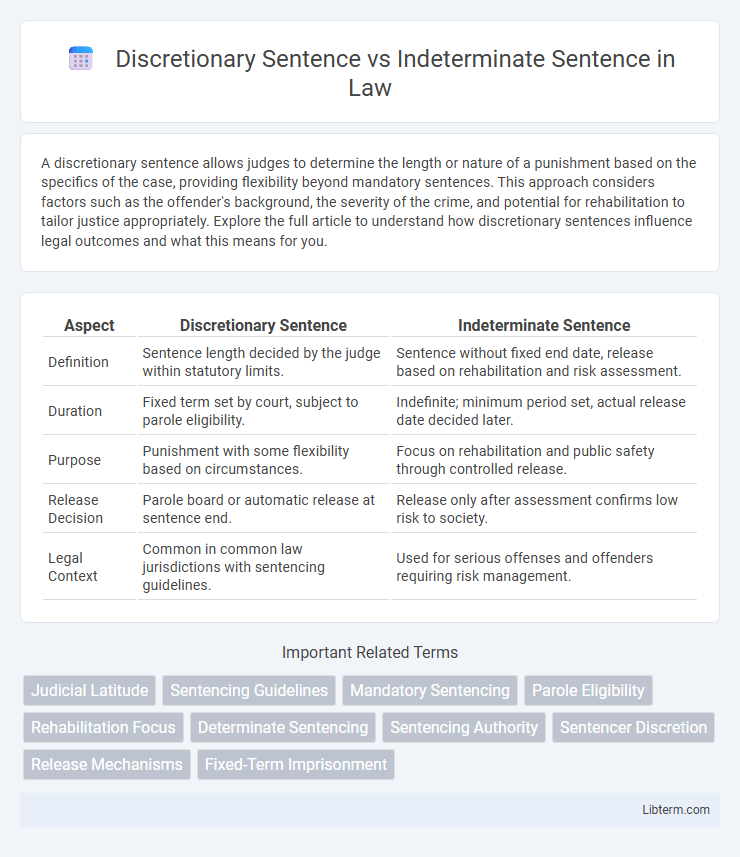A discretionary sentence allows judges to determine the length or nature of a punishment based on the specifics of the case, providing flexibility beyond mandatory sentences. This approach considers factors such as the offender's background, the severity of the crime, and potential for rehabilitation to tailor justice appropriately. Explore the full article to understand how discretionary sentences influence legal outcomes and what this means for you.
Table of Comparison
| Aspect | Discretionary Sentence | Indeterminate Sentence |
|---|---|---|
| Definition | Sentence length decided by the judge within statutory limits. | Sentence without fixed end date, release based on rehabilitation and risk assessment. |
| Duration | Fixed term set by court, subject to parole eligibility. | Indefinite; minimum period set, actual release date decided later. |
| Purpose | Punishment with some flexibility based on circumstances. | Focus on rehabilitation and public safety through controlled release. |
| Release Decision | Parole board or automatic release at sentence end. | Release only after assessment confirms low risk to society. |
| Legal Context | Common in common law jurisdictions with sentencing guidelines. | Used for serious offenses and offenders requiring risk management. |
Introduction to Criminal Sentencing
Discretionary sentences empower judges to set punishment length based on case specifics, including offender background and crime severity, allowing tailored justice outcomes. Indeterminate sentences, however, assign a minimum term followed by an undefined maximum, often relying on parole boards to determine release timing based on rehabilitation progress. Both sentencing types reflect judicial strategies balancing public safety, offender reform, and legal flexibility within criminal sentencing frameworks.
Defining Discretionary Sentence
A discretionary sentence is a type of criminal sentence where the judge has the authority to determine the length and conditions of imprisonment based on the specifics of the case and the offender's circumstances. This sentencing contrasts with an indeterminate sentence, which sets a minimum and maximum duration, often leaving parole eligibility to a board's discretion. Discretionary sentences allow flexibility in punishment, aiming to balance rehabilitation and public safety.
Understanding Indeterminate Sentence
Indeterminate sentences allow judges to set a minimum and maximum term, providing flexibility for parole based on rehabilitation progress, unlike discretionary sentences where fixed terms are imposed. This system aims to balance public safety with individualized treatment, encouraging inmate reform before release consideration. Indeterminate sentencing is often applied in cases involving serious offenses or offenders requiring tailored rehabilitation efforts.
Key Differences Between Discretionary and Indeterminate Sentences
Discretionary sentences grant judges the authority to determine the sentence length within statutory limits, providing flexibility based on case specifics, while indeterminate sentences assign a minimum and maximum term, with parole boards deciding actual release dates. Discretionary sentences emphasize judicial discretion at sentencing, whereas indeterminate sentences rely on post-sentencing review and rehabilitation assessment. The key difference lies in sentencing control: discretionary sentences depend on judicial decision-making, indeterminate sentences shift control to parole authorities over time served.
Legal Framework Governing Both Sentences
Discretionary sentences are governed by statutory frameworks that allow judges to impose sentences within a prescribed range based on case-specific factors, emphasizing judicial discretion within fixed sentencing guidelines. Indeterminate sentences fall under legal regimes permitting variable sentence lengths, often linked to parole board decisions and rehabilitation assessments, reflecting an emphasis on correctional objectives rather than fixed terms. Both sentencing types operate under distinct legislations such as the Sentencing Act and correctional statutes, which define the conditions, eligibility, and duration parameters unique to each model.
Advantages of Discretionary Sentencing
Discretionary sentencing allows judges to tailor penalties based on the individual circumstances of each case, promoting fairness and proportionality in the justice system. This flexibility enables the consideration of mitigating factors, such as the defendant's background and potential for rehabilitation, which can lead to more effective reintegration into society. Compared to indeterminate sentencing, which assigns a fixed range without judicial discretion, discretionary sentencing supports personalized justice and reduces unnecessary incarceration.
Benefits and Drawbacks of Indeterminate Sentencing
Indeterminate sentencing allows for a flexible prison term based on rehabilitation progress, which can reduce overcrowding and promote individualized treatment but may lead to uncertainty and perceived unfairness in sentencing consistency. This approach benefits offenders by supporting tailored rehabilitation plans and encouraging good behavior, yet it can cause prolonged incarceration for some due to unpredictable release dates. Drawbacks include challenges in maintaining transparency and potential biases in parole decisions, impacting public trust in the criminal justice system.
Judicial Role in Sentencing Decisions
Discretionary sentences grant judges the authority to tailor punishments based on case specifics, allowing flexibility in sentencing outcomes. Indeterminate sentences, however, involve fixed minimum terms with release contingent on rehabilitation evaluations, limiting judicial discretion post-sentencing. Judicial roles in sentencing thus shift from active decision-makers in discretionary cases to more constrained evaluators within indeterminate frameworks.
Impact on Rehabilitation and Recidivism
Discretionary sentences allow judges to tailor punishments based on individual circumstances, often offering more opportunities for rehabilitation through treatment programs and community supervision, which can lower recidivism rates. Indeterminate sentences, with their open-ended duration and parole eligibility tied to demonstrated rehabilitation, incentivize inmates to engage in reformative efforts but may create uncertainty that affects long-term reintegration planning. Both sentencing types influence rehabilitation pathways differently, with discretionary sentences providing immediate tailored support and indeterminate sentences emphasizing behavioral change over time to reduce repeat offenses.
Conclusion: Which Sentence Best Serves Justice?
Discretionary sentences offer judges flexibility to tailor punishment based on case specifics, promoting individualized justice. Indeterminate sentences emphasize rehabilitation by allowing release decisions to consider offender progress, yet may prolong uncertainty for inmates and victims. Balancing these approaches, a hybrid model integrating judicial discretion with structured parole review best serves justice by aligning punishment severity with offender accountability and societal safety.
Discretionary Sentence Infographic

 libterm.com
libterm.com